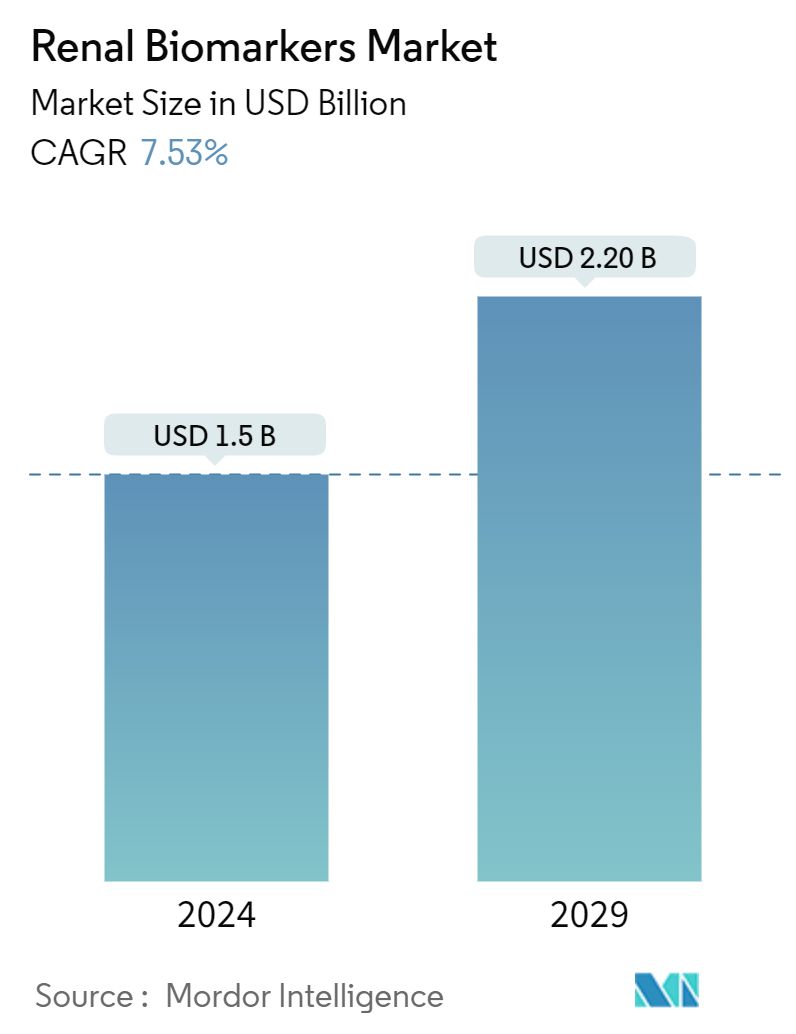Market Size of Renal Biomarkers Industry

| Study Period | 2019 - 2029 |
| Market Size (2024) | USD 1.5 Billion |
| Market Size (2029) | USD 2.20 Billion |
| CAGR (2024 - 2029) | 7.53 % |
| Fastest Growing Market | Asia-Pacific |
| Largest Market | North America |
| Market Concentration | Medium |
Major Players
*Disclaimer: Major Players sorted in no particular order |
Renal Biomarkers Market Analysis
The Renal Biomarkers Market size is estimated at USD 1.5 billion in 2024, and is expected to reach USD 2.20 billion by 2029, growing at a CAGR of 7.53% during the forecast period (2024-2029).
The key factors propelling the growth of the studied market are the rising prevalence of various kidney-related diseases and diseases such as diabetes and high blood pressure, which are the leading causes of renal diseases, coupled with rapid technological advancements in the field of genetics.
The growing burden of various kidney-related health conditions has been on the rise in recent years. The rising prevalence of kidney diseases such as glomerulonephritis, kidney failure, polycystic kidney disease, lupus nephritis, and analgesic nephropathy, kidney infections, among others, are expected to increase the demand for the diagnostics tests used for the identification of renal biomarkers that are used for the diagnosis of these diseases, which ultimately drive the studied market over the forecasted period. For instance, according to the American Kidney Fund Organization Updated data in 2024, around 37 million Americans have kidney disease. Kidney disease is growing at an alarming rate. Hence, the high prevalence of kidney-related diseases in different countries worldwide is expected to boost the studied market over the forecast period.
The rising prevalence of diabetes cases can lead to an increasing prevalence of kidney-related diseases, which is expected to drive the studied market over the forecasted period. For instance, as per the 2022 update from the International Diabetic Federation (IDF), approximately 537 million adults (20-79 years) will be living with diabetes across the globe in 2021, and the number is projected to rise to 643 million by 2030 and 783 million by 2045. Hence, the significant increase in diabetes that can lead to kidney diseases and the huge role of renal biomarkers testing in diagnosing and managing these diseases are expected to drive the studied market over the forecast period.
Additionally, strategic activities by market players, such as partnerships, mergers and acquisitions, and product launches and approvals, are expected to propel the market's growth. For instance, in June 2023, Renalytix PLC reported that the United States Food and Drug Administration (FDA) had granted De Novo marketing authorization for its KidneyIntelX.dkd prognostic test. This affirms KidneyIntelX as a first-in-class, artificial intelligence-enabled prognostic testing platform to guide care management for adults with type 2 diabetes and early-stage chronic (diabetic) kidney disease. Renalytix believes FDA authorization will increase test adoption, inform clinical guidelines, expand insurance coverage, and pursue additional international regulatory approvals.
Similarly, in August 2023, SphingoTec GmbH and Boditech Med Inc. entered into a development agreement aimed at developing the kidney function biomarker penKid. The MDA solidifies the partnership between SphingoTec GmbH and Boditech Med Inc., aiming to support the successful commercialization of the assay for the biomarker penKid on the AFIAS (Automated Fluorescent Immunoassay System) platforms. Such strategic initiatives are projected to drive the market growth significantly over the forecast period.
Thus, due to the aforementioned factors, such as the growing burden of kidney diseases and strategic activities by market players, the renal biomarkers market is expected to grow at a significant rate during the forecast period. However, regulatory and reimbursement system issues may hamper the market's growth over the forecast period.
Renal Biomarkers Industry Segmentation
As per the scope of the report, renal biomarkers are biomarkers that help diagnose or identify patients at risk of developing kidney diseases by measuring their blood or urine levels. They are commonly released in acute or chronic kidney injuries, which are characterized by the rapid or gradual loss of kidney function, resulting in serious clinical implications. The renal biomarkers market is segmented by biomarker type, diagnostic technique, end user, and geography.
The market is segmented as a functional biomarker, up-regulated protein, and other biomarker types based on biomarker type. Based on diagnostic technique, the market is segmented as enzyme-linked immunosorbent assay, particle-enhanced turbidimetric immunoassay (PETIA), colorimetric assay, chemiluminescent enzyme immunoassay (CLIA), and liquid chromatography-mass spectrometry (LS-MS). Based on end-users, the market is segmented as hospitals, diagnostic laboratories, and other end users. The market is segmented based on geography into North America, Europe, Asia-Pacific, the Middle East, Africa, and South America. The market report also covers the estimated market sizes and trends for 17 countries across major global regions. The report offers the value (in USD) for the above segments.
| By Biomarker Type | |||||
| |||||
| |||||
| Other Biomarker Types |
| By Diagnostic Technique | |
| Enzyme-linked Immunosorbent Assay | |
| Particle-enhanced Turbidimetric Immunoassay (PETIA) | |
| Colorimetric Assay | |
| Chemiluminescent Enzyme Immunoassay (CLIA) | |
| Liquid Chromatography Mass Spectrometry (LS-MS) |
| By End User | |
| Hospitals | |
| Diagnostic Laboratories | |
| Other End Users |
| Geography | ||||||||
| ||||||||
| ||||||||
| ||||||||
| ||||||||
|
Renal Biomarkers Market Size Summary
The renal biomarkers market is poised for significant growth, driven by the increasing prevalence of kidney-related diseases and advancements in genetic technologies. The rising incidence of conditions such as glomerulonephritis, kidney failure, and diabetes-related kidney diseases is fueling the demand for diagnostic tests that identify renal biomarkers. These tests are crucial for the early diagnosis and management of renal diseases, which are becoming more common globally. Strategic initiatives by key market players, including partnerships, mergers, and product launches, are further propelling market expansion. Notable developments, such as FDA approvals for innovative diagnostic tests, are expected to enhance test adoption and expand market reach.
North America, particularly the United States, holds a dominant position in the renal biomarkers market, supported by a high prevalence of chronic kidney disorders and a robust focus on developing advanced diagnostic tests. Government initiatives and strategic activities by market players, such as clinical trials and product launches, are contributing to the region's market growth. The competitive landscape is characterized by the presence of major companies and the emergence of mid-size to smaller firms introducing cost-effective technologies. Collaborations and partnerships, like those between LifeLabs and Klinrisk, are enhancing the availability and adoption of renal biomarkers, further driving market growth.
Renal Biomarkers Market Size - Table of Contents
-
1. MARKET DYNAMICS
-
1.1 Market Overview
-
1.2 Market Drivers
-
1.2.1 Rising Prevalence of Various Kidney-related Diseases
-
1.2.2 High Prevalence of Diabetes and High Blood Pressure, the Leading Cause of Renal Diseases
-
1.2.3 Rapid Technological Advances in the Field of Genetics
-
-
1.3 Market Restraints
-
1.3.1 Issues Related to Regulatory and Reimbursement Systems
-
-
1.4 Porter Five Forces
-
1.4.1 Bargaining Power of Suppliers
-
1.4.2 Bargaining Power of Consumers
-
1.4.3 Threat of New Entrants
-
1.4.4 Threat of Substitute Products/Services
-
1.4.5 Intensity of Competitive Rivalry
-
-
-
2. MARKET SEGMENTATION (Market Size by Value - USD)
-
2.1 By Biomarker Type
-
2.1.1 Functional Biomarker
-
2.1.1.1 Serum Creatinine
-
2.1.1.2 Serum Cystatin C
-
2.1.1.3 Urine Albumin
-
-
2.1.2 Up-regulated Protein
-
2.1.2.1 Neutrophil Gelatinase-Associated Lipocalin (NGAL)
-
2.1.2.2 Kidney Injury Molecule-1
-
2.1.2.3 INTERLEUKIN-18
-
-
2.1.3 Other Biomarker Types
-
-
2.2 By Diagnostic Technique
-
2.2.1 Enzyme-linked Immunosorbent Assay
-
2.2.2 Particle-enhanced Turbidimetric Immunoassay (PETIA)
-
2.2.3 Colorimetric Assay
-
2.2.4 Chemiluminescent Enzyme Immunoassay (CLIA)
-
2.2.5 Liquid Chromatography Mass Spectrometry (LS-MS)
-
-
2.3 By End User
-
2.3.1 Hospitals
-
2.3.2 Diagnostic Laboratories
-
2.3.3 Other End Users
-
-
2.4 Geography
-
2.4.1 North America
-
2.4.1.1 United States
-
2.4.1.2 Canada
-
2.4.1.3 Mexico
-
-
2.4.2 Europe
-
2.4.2.1 Germany
-
2.4.2.2 United Kingdom
-
2.4.2.3 France
-
2.4.2.4 Italy
-
2.4.2.5 Spain
-
2.4.2.6 Rest of Europe
-
-
2.4.3 Asia-Pacific
-
2.4.3.1 China
-
2.4.3.2 Japan
-
2.4.3.3 India
-
2.4.3.4 Australia
-
2.4.3.5 South Korea
-
2.4.3.6 Rest of Asia-Pacific
-
-
2.4.4 Middle East and Africa
-
2.4.4.1 GCC
-
2.4.4.2 South Africa
-
2.4.4.3 Rest of Middle East and Africa
-
-
2.4.5 South America
-
2.4.5.1 Brazil
-
2.4.5.2 Argentina
-
2.4.5.3 Rest of South America
-
-
-
Renal Biomarkers Market Size FAQs
How big is the Renal Biomarkers Market?
The Renal Biomarkers Market size is expected to reach USD 1.5 billion in 2024 and grow at a CAGR of 7.53% to reach USD 2.20 billion by 2029.
What is the current Renal Biomarkers Market size?
In 2024, the Renal Biomarkers Market size is expected to reach USD 1.5 billion.

